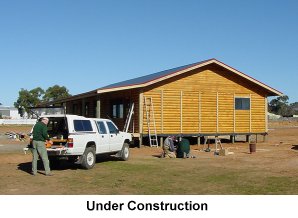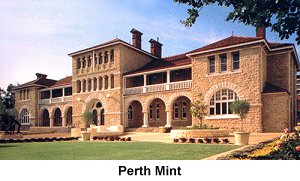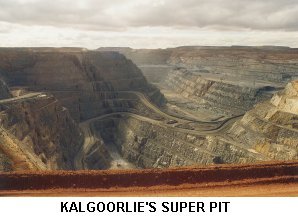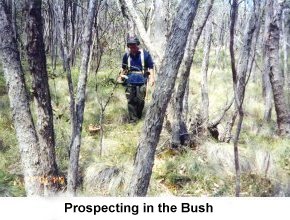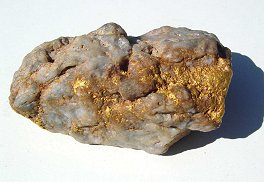
| September 2002 | ||||||||||||||||||||||||
|
||||||||||||||||||||||||
Contents
|
||||||||||||||||||||||||
1. EDITORIAL Goldnet Australia is about to change dramatically. Previously we advised that we would be developing a chat site - and forums. In fact the site will be totally redeveloped at the front end - to cater for more interactive contributions from our members. Included in the site will be a direct facility to sell your own gold fossicking gear - where you can describe and upload your own "for sale" products yourself. Additionally - there will be a facility to sell gold in all forms. And you can upload all the "for sale" details and your pics quickly and easily. There will be a facility for members to post articles - similar to the magazine articles that now appear - along with pics. This will make the site extremely easy for you to use. This alteration will take some time - as one does not build a complete web site in a few minutes. We can also proudly advise that this magazine is now read by over 12,000 subscribers. A great achievment indeed - and one we are very proud of. One other piece of news - is that the Gold Expo that is usually undertaken in Ballarat in March - will be suspended for one year. We have consciously made the decision to move the Expo into Melbourne. However finding a suitable site in Melbourne at a realistic price and with all the required facilities has proved a difficult task at this time. Further investigations are being made and a much bigger and more extensive Expo is planned for March 2004. We apologise for the delay this month. This was due to the Editor being sick. VALE JOHN MORRIS
I have the sad duty of informing you that PMAV Life Member and Treasurer John Winter passed away this morning - Sunday 15th September 2002.
Rita Bentley Editor Email: [email protected]
All material in this magazine is copyright and may not be reproduced in any part or form whatsoever without written permission from the publisher.
|
||||||||||||||||||||||||
2. COILTEK IN VICTORIA
 by Brad Williams Coiltek have embarked on a new venture which is changing the focus of the company direction. With the implementation of a new retail outlet centred in the heart of the Golden Triangle in Victoria the Coiltek juggernaut marches on to even greater prosperity for the industry as a whole.
Monday the 2nd of September saw the new Coiltek Gold Centre open at Maryborough, Victoria. The day was a boomer with a phenomenal number of prospectors and interested participants from all over the gold fields.
There will be a full range of all Coiltek products for the discerning detectorist - along with other allied products from other manufacturers that compliment the discerning prospector. The retail outlet will be a one stop shop for all your prospecting needs, and will have an outstanding range of products - second to none anywhere in Australia. Prospecting guided tours will be available under the expert guidance of local operators and there are plenty of hire detectors in the form of the Minelab SD and GP range. Second hand detectors, both gold and coin machines are available for sale while a Clearing House for second hand detectors and allied equipment is expected to be up and running in the near future.
Coiltek are also specialising in Solar Energy systems for prospectors.
This means a system can be specially designed for individual needs where there is no expensive overkill, or lack of power due to under quoting.
If you want to build a solar energy setup for your next expedition get the best advice, and equipment from Coiltek. Navigation takes up an entire section of the shop with maps, GPS, compasses, and information books to compliment the maps, etc. Some new and exciting products ar on the drawing board for this area as well.
Walco Super Picks have an entire display section to show their picks, belts, pick holders and other equipment. Staff at the new Coiltek Gold Centre will be Jim Foster and his wife Cheryl, managing. John Morris on Friday and Saturdays, with John Gladdis, who is now again involved with Coiltek floating in and out, mixing tours and other duties as required. This new venture for Coiltek is a positive statement to the industry and will be a catalyst for the industry to positively progress in this great detecting area.
|
||||||||||||||||||||||||
|
||||||||||||||||||||||||
3. THE PERTH MINT by Craig Wilson - courtesy Perth Mint The Perth Mint is Australia's oldest operating Mint, established in 1899 to mint gold sovereigns for the British Empire. The Mint is owned by the Western Australian Government and is Australia's specialist precious metals mint, producing collector and investment coins for world markets. The Perth Mint has played a central role in the development of Western Australia's gold industry During the 19th Century, three branches of the Royal Mint of London were established in the Australian colonies to refine gold from the gold rushes and to mint gold sovereigns and half-sovereigns for the British Empire.
The Sydney branch opened in 1855, the Melbourne branch in 1872 and the Perth branch on 20 June 1899, two years before Australia's Federation in 1901.
Before 1901, Australia still did not exist as a nation, thus the States were operating as separate colonies. The then Premier of Western Australia, Sir John Forrest, asked the British Government to establish a branch of the Royal Mint in Perth to refine the gold being produced in the Eastern goldfields and to mint it into British gold coins to be used as currency in the colony.
The legal heritage of the Perth Mint goes back much further than the building itself. Having been established as a branch of London's Royal Mint, the rights, duties, privileges and responsibilities of the Crown as they applied to the Royal Mint were also transmitted to The Perth Mint. Thus, a link exists between The Perth Mint and the venerable institution of the Royal Mint on Tower Hill, London, where the Mint has stood since the Romans first struck coins there in 287AD. The Perth Mint remained under the jurisdiction of Britain, until 1 July 1970, when theMint became a statutory authority of the Government of Western Australia. It remains a State institution, though the Sydney and Melbourne mints ceased to operate long ago, largely due to the decline of gold production in the Eastern States. Today, more than 100 years after its opening, The Perth Mint continues to function, and is one of the oldest Mints in the world still operating from its original premises. Throughout its long history, the Perth Mint has fulfilled the dual roles of precious metal refining and coining. In its first 100 years of operation, the Mint's refined fine gold output totalled 4,500tonnes, representing 3.25% of the total tonnage of gold produced by mankind. This would have formed a solid gold cube measuring some six metres on each side. The refinery operated at the original Hay Street, East Perth, premises from June 1899 until April 1990, when it was moved to a new state-of-the-art facility at Newburn, adjacent to Perth's International Airport. In December 1998, the Mint's refining and precious metals industrial products businesses were merged with those of Golden West (Australasia) Pty Ltd, to form the Australian Gold Refineries Joint Venture (AGR JV), with the Mint, operated by Gold Corporation, holding 50% equity.
Golden West's 50% interest in AGR JV was later sold, in August 2001, to the Australian Gold Alliance Pty Ltd (AGA), the shareholders of which will be a consortium of major gold producers. The Mint produces a wide range of gold and silver bullion bars (silver is a bi-product of gold). For the investor, gold is available in medallion-like ingots containing as little as half an ounce of gold, up to bars of 400 ounces, worth about A$200,000 each, the standard form for professional gold trading around the world. Gold and silver alloy and fabricated forms to satisfy the requirements of jewellers, dentists and other industrial users are also prepared. The Perth Mint has also played an advisory role in establishing several other international mints and refineries, including the world's largest, South Africa's Rand Refinery In the early days of gold mining and into the 1920s, the bulk of the gold produced in Western Australia was converted into 22-carat alloy and issued as sovereigns and half-sovereigns for circulation and government reserves. By the time minting of gold coinage ceased in 1931, the Perth Mint had issued over106 million British sovereigns and nearly 735,000 half-sovereigns. These were not strictly Australian coins, as they were identical to those struck by all branches of theRoyal Mint throughout the Empire The Perth Mint also produced large volumes of Australia's conventional legal tender coinage over many years until 1984. Before Australia's Federation, the silver and bronze coins in circulation were also British, but shortly after the emergence of Australia as a Commonwealth on 1 January 1901, plans were made for a new coinage, and the Australian Coinage Act was proclaimed in 1909. The first Australian silver coins (florins, shillings, sixpences and threepences) were dated 1910 and the first bronze coins (pennies and half-pennies) were dated 1911. The new coins were initially struck in England, Sydney, Melbourne and for a short time, in India. In 1922, The Perth Mint made pennies for the first time. There was a break in coin production in Perth between 1931 and 1940, but from 1940 until 1964, pennies or half-pennies came off the presses continuously. By 1964, 438 million pennies and 256 million half-pennies had been produced at The Perth Mint, with a small issue of 1.3 million shillings dated 1946 also struck. In 1964, the Mint turned its energies to stock-piling bronze coins in preparation for Australia's change-over to decimal currency in 1966. A break occurred between 1968 and 1973, but steady production of two-cent coins continued until the end of 1983, by which time 829 million two-cent coins and 26 million one-cent coins had been minted in Perth.
Their legal tender status is the key to their international tradability because, just as in King Croesus's day, the government backing for the coins is the guarantee of the weight and purity of the gold, platinum and silver they contain. Altogether, from November 1986 to the end of June 2001, The Perth Mint in its new era converted more than 135 tonnes of gold, 305 tonnes of silver and 18 tonnes of platinum into value-added coins, 85% of which were sold overseas. This accomplishment has seen The Perth Mint (Gold Corporation) consistently ranked among Australia's top 30 export earners. The Perth Mint, in partnership with the Royal Australia Mint, produced and marketed the official commemorative coins and medallions of the Sydney 2000 Olympic and Paralympic Games. The prestigious Sydney 2000 Olympic Coin Program (launched on 9 October 1997) was the official coin program commemorating the Sydney Olympic Games, and the most significant coin collection ever released in Australia for international distribution. The Program was authorised by the Commonwealth Treasury, thus all coins were issued as legal tender of Australia. The unique collection of eight gold coins, sixteen silver coins, twenty-eight bronze 'sports' coins and the Silver Kilo Olympic Masterpiece, were released between October 1997 and May 2000. The Silver Kilo Olympic Masterpiece was the largest Olympic coin ever produced and the first Olympic coin to feature all the 28 sports of an Olympic Games. The two mints also shared the honour of manufacturing the prestigious Sydney 2000 Olympic and Paralympic Victory Medals. In the early 1990s, the Mint's majestic wrought iron gates that had been locked to the general public for more than 90 years, were thrown open. This followed the establishment of The Perth Mint Shop, in October 1990, and the Gold Exhibition, in December 1993. The Perth Mint has since become a major tourist attraction, winning multiple State and National tourism awards and hosting more than 120,000 visitors a year. Open seven days a week, its most popular its most popular attraction is an hourly Gold Pour, held in the original Melthouse.
|
||||||||||||||||||||||||
|
||||||||||||||||||||||||
4. KALGOORLIE'S GOLDEN MILE by Jim Bowman Much had been written about the fabulous golden wealth at Kalgoorlie, in Western Australia. It is indeed one of the wealthiest golden places on earth. For over 100 years the golden mile has produced gold in extraordinary quantities, and provided massive wealth both for the finders and also for the State when economic times were hard.
Although the discovery of this gold field is attributed to Paddy Hannan, there were his two partners, Tom Flanagan and Dan Shea, who were also intricately involved. As Paddy registered the claim - the credit went to him.
Within a few short days over 700 diggers were working their claims.
The best gold was running north and south from the first claims - so as more prospectors arrived they took up leases running in those directions.
It took until 1903 for the government to provide a pipe line that took water to the region. This relieved the terrible stress and restrictions that the lack of water obviously had on restricting activity on the gold fields. Ironically, although this was an exceptional golden area - the real wealth was not recognised for several years. Companies were reluctant to invest and progress was slow with investors scarce. It really took about 6 - 7 years before the real wealth that lay under the surface was recognised. Even then it was slow going, but eventually the gold field developed into the greatest gold field the world has ever seen. And produce it did - the great golden mile is still producing today some 100 plus years after. Today you will not find a pick and shovel at the golden mile - other than in a museum, and the huge trucks and explosives have taken over from those primitive methods. The great Super Pit is a huge pit, which covers a vast area just east of Kalgoorlie, and when viewing the pit from the tourist platform, the large trucks look like toys as they traverse the long and winding roads to the surface. Early production figures from the Golden Mile were as follows.
These figures relate up to 1906 only. Today the real wealth of the Golden Mile is still beling assessed.
|
||||||||||||||||||||||||
|
||||||||||||||||||||||||
|
5. THE FRATERNITY OF PROSPECTORS  by Brad Williams It is amazing just how similar gold prospectors are right around the world. The lure of the golden yellow metal knows no bounds around the globe, and the quality of the characters that abound looking for the hidden gold is to say the least awesome. If you have spent time in the gold fields, as I have, you come across some incredible characters. The one thing that stands these men and woman out from the also rans, is the fact that they are doing something positive in their lives and above all, generally are prepared to share at least their experiences, warts and all. Now disclosing where they found a good patch or that big nugget might be another matter, but overall those involved are a great bunch of characters. And of course these characters are not just confined to one area or for that matter country. They are seen globally. Now all could be described as characters, but as the gold prospecting fraternity is a diverse bunch, we have more than our fair share of prospectors that are outstanding in personality and demeanour, so much so, that that are noted across the globe.
But it's not only these characters who contribute to the net comments that I am talking about. It's the real characters who ply their trade in the gold fields with a consistency and determination that make them legends. Most of these characters are more than willing to impart their knowledge and help a novice to find that first illusive piece of gold. I remember the first time I hired a detector and went detecting. I had no idea what I was doing and spent the best part of the day frustrated and eventually very disappointed. When expressing this to John Gladdis - he took me under his wing and the next time I went to Victoria, I met John and under his expert tutorage, the whole idea began to fall into place. It was then that I began to find gold. He sure put me on the right track.
Perhaps if you sit around a camp fire with some of these folks, and listen to the bush yarns they can tell, sometimes quite late into the night, you are spell bound by the intriguing stories they relate, some with ever greater gold finds, and with of course the obligatory tall stories that abound throughout to make the tale, somewhat taller. One should remember that Aussies are great practical jokers. It is part of the psyche to play a joke on some unsuspecting character. These are often played on your closest friends and also on overseas visitors. Tall stories abound, with wild creatures a favourite topic. I once heard one tale of a very large big red kangaroo, who, according to the tale, was shot at by a roo shooter. He missed and the gun jammed, and upon seeing this the roo turned and bounded right up to him, smacked him in the mouth with his paw, knocking him to the ground, then turned around and bounded off - leaving the shooter stunned and gob smacked. Now I could not say that this didn't happen, but some stories do get taller as they age. I digress somewhat from the subject of that great bond that binds prospectors. It certainly exists, and is enhanced on each and every occasion that prospectors venture forth into the gold fields areas to find gold. There are many stories of characters who have shared great wealth with their mates. This was abundantly evident 150 years ago in the gold fields, where mateship and sharing meant more to those men that a few £.
Perhaps in some instances that cannot be said today that the same bond exists between some prospectors, as there are some loners out there.
Generally though, the great camaraderie that is displayed is not just noted but is respected by all those who seriously prospect. It will be a very say day if this fraternity ceases to exist. I cannot see that happening, as the great spirit of the prospector is alive and well, just as it was 150 plus years ago. Keep up the good work you guys. Just don't get too tall with those yarns.
|
||||||||||||||||||||||||
|
||||||||||||||||||||||||
6. GLOBAL GOLD MOVEMENT by Laurelle Murphy Gold changes globally Changes in holdings, as recorded by the International Monetary Fund's International Financial Statistics, are allocated between columns according to the probable reason for them; for some countries this is subject to some uncertainty. Trading refers to cases where the central banks of gold producing countries acquire newly-mined gold which they may later sell, swap or retain in reserves.Some of these countries aim to build up their reserves over the longer-term. Overall This includes all countries and international financial institutions including ones where reserves changed by less than one tonne.
Austria.
Brazil
Canada
Chile.
Czech Republic.
ECB/ESCB/Greece.
Japan
Netherlands
Russia
South Africa
Switzerland
United Kingdon
Uruguay
Venezuela
Washington Agreement on Gold.
Yugoslavia The USA, the IMF and the BIS, while not formally signing the agreement, have associated themselves with it and the Japanese also indicated that they have no plans to sell gold. The USA's gold holdings undergo periodic fluctuations due to arrangements for purchasing and then supplying gold to the US mint for the manufacture of bullion coins. (Gold from the reserve is normally used for commemorative coins.) In many cases the reason for the movement in a country's gold reserves is known or suspected. But in others it is not. Allocations will at times be tentative and will include a number of instances where the reason for the change is not known.
|
||||||||||||||||||||||||
|
||||||||||||||||||||||||
7. FLECKS ! - Glints from here and there
|
||||||||||||||||||||||||
|
PMAV Media Release - 8/9/02 Eureka hypocrisy. The Bracks Government was put on notice today that Victoria�s prospectors and miners will not accept any attempts to politicise the 150th Anniversary of the Eureka uprising in 2004. Prospectors and Miners Association President, Rita Bentley, today expressed serious concerns with the Premier�s moves to lead the Eureka 150 celebrations. "How can Premier Bracks talk about Victoria being the birthplace of democracy when his Government refuses to listen to the people? The Government�s policies are deliberately removing small miners from the bush and yet Bracks is proposing to use the anniversary of a miners revolt against unfair Government for his own political gain. This is the height of hypocrisy." "Of most serious concern to prospectors and miners is the pending legislation to create a series of new national and state parks across the goldfields. This will significantly reduce the areas available for prospecting and mining. Additionally, the Government is proposing to increase requirements on small mining operations to make them equal with the largest operations such as the brown coal operations in the Latrobe Valley and the Stawell gold mine. This will be the end of the small, family operated sector of the mining industry � this Government that continually claims to be caring simply doesn�t give a damn." Prospectors and miners are not alone in their criticism of the Government�s policies on traditional activities. The Bracks� Government has also faced intense criticism from most other bush user groups on its handling of the Box and Ironbark issue, pest plants and animals, marine parks, etc.
The creation of the Bush Users Group, which now represents the interests of over 270,000 Victorians, was brought about by the frustration of many bush users that Government was ignoring their concerns regarding the fraudulent nature of the Environment Conservation Council�s investigation into the box ironbark area. "If Premier Bracks and his Government don�t start really taking notice of the concerns of the people in the bush they may just be facing another Eureka uprising through the ballot box", Ms Bentley concluded.
|
||||||||||||||||||||||||
|
||||||||||||||||||||||||
8. STRIKES Recent Finds
|
||||||||||||||||||||||||
|
||||||||||||||||||||||||
|
9. THE NEW LODE - Next Month's Issue
|
||||||||||||||||||||||||
|
||||||||||||||||||||||||
